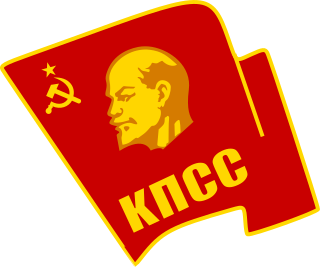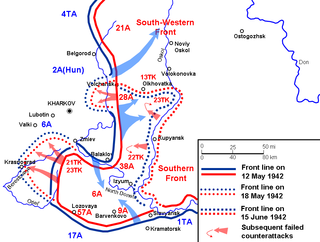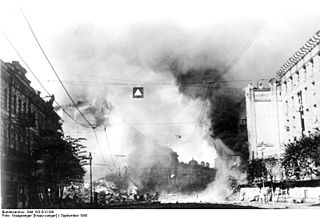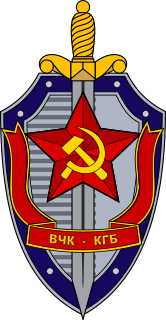Related Research Articles

Belarus, officially the Republic of Belarus, and historically Byelorussia, is a landlocked country in Eastern Europe. It is bordered by Russia to the east and northeast, Ukraine to the south, Poland to the west, and Lithuania and Latvia to the northwest. Covering an area of 207,600 square kilometres (80,200 sq mi) and with a population of 9.3 million, Belarus is the 13th-largest and the 20th-most populous country in Europe. The country is administratively divided into seven regions. Minsk is the capital and largest city.

In the Battle of Stalingrad, Germany and its allies fought the Soviet Union for control of the city of Stalingrad in Southern Russia. The battle was marked by fierce close-quarters combat and direct assaults on civilians in air raids. The Battle of Stalingrad was the deadliest battle to take place during the Second World War and is one of the bloodiest battles in the history of warfare, with an estimated 2 million total casualties. The battle marked a turning point in the war as it forced the Oberkommando der Wehrmacht to withdraw considerable military forces from other theaters of war to replace their losses on the eastern front. The victory at Stalingrad energized the Red Army and shifted the balance of power in the favor of the Soviets.

The Communist Party of the Soviet Union (CPSU), also known by various other names during its history, was the founding and ruling party of the Soviet Union. The CPSU was the sole governing party of the Soviet Union until 1990 when the Congress of People's Deputies modified Article 6 of the 1977 Soviet Constitution, which had previously granted the CPSU a monopoly over the political system.

Operation Barbarossa was the code name for the invasion of the Soviet Union by Nazi Germany and some of its Axis allies, which started on Sunday, 22 June 1941, during World War II. The operation was named after Frederick Barbarossa, a 12th-century Holy Roman emperor and German king. The operation put into action Nazi Germany's ideological goal of conquering the western Soviet Union to repopulate it with Germans. The German Generalplan Ost aimed to use some of the conquered people as forced labour for the Axis war effort while acquiring the oil reserves of the Caucasus as well as the agricultural resources of various Soviet territories. Their ultimate goal included the eventual extermination, enslavement, Germanization and mass deportation to Siberia of the Slavic peoples, and to create more Lebensraum for Germany.

Russia, or the Russian Federation, is a transcontinental country spanning Eastern Europe and Northern Asia. It is the largest country in the world by area, covering over 17,125,191 square kilometres (6,612,073 sq mi), and encompassing one-eighth of Earth's inhabitable landmass. Russia extends across eleven time zones and borders sixteen sovereign nations, the most of any country in the world. It is the ninth-most populous country and the most populous country in Europe, with a population of 145.5 million. Moscow, the capital, is the largest city entirely within Europe, while Saint Petersburg is the country's second-largest city and cultural centre. Other major urban areas include Novosibirsk, Yekaterinburg, Nizhny Novgorod and Kazan.

Ukraine is a country in Eastern Europe. It is the second-largest country by area in Europe after Russia, which it borders to the east and north-east. Ukraine also shares borders with Belarus to the north; Poland, Slovakia, and Hungary to the west; Romania and Moldova to the south; and has a coastline along the Sea of Azov and the Black Sea. It spans an area of 603,628 km2 (233,062 sq mi), with a population of 43.6 million, and is the eighth-most populous country in Europe. The nation's capital and largest city is Kyiv.

The Battle of Kursk was a Second World War engagement between German and Soviet forces on the Eastern Front near Kursk in the Soviet Union, during July and August 1943. The battle began with the launch of the German offensive Operation Citadel, on 5 July, which had the objective of pinching off the Kursk salient with attacks on the base of the salient from north and south simultaneously. After the German offensive stalled on the northern side of the salient, on 12 July the Soviets commenced their Kursk Strategic Offensive Operation with the launch of Operation Kutuzov against the rear of the German forces on the same side. On the southern side, the Soviets also launched powerful counterattacks the same day, one of which led to a large armoured clash, the Battle of Prokhorovka. On 3 August, the Soviets began the second phase of the Kursk Strategic Offensive Operation with the launch of Operation Polkovodets Rumyantsev against the German forces on the southern side of the salient.

The Winter War, also known as First Soviet-Finnish War, was a war between the Soviet Union (USSR) and Finland. It began with a Soviet invasion of Finland on 30 November 1939, three months after the outbreak of World War II; the war ended three and a half months later with the Moscow Peace Treaty on 13 March 1940. Despite superior military strength, especially in tanks and aircraft, the Soviet Union suffered severe losses and initially made little headway. The League of Nations deemed the attack illegal and expelled the Soviet Union from the organisation.

The Russians are an East Slavic ethnic group native to Eastern Europe, who share a common Russian ancestry, culture, and history. Russian, the most spoken Slavic language, is the shared mother tongue of the Russians; and Orthodox Christianity is their historical religion since the 11th century. They are the largest Slavic nation, as well as the largest European nation.

The Soviet Air Forces were one of the air forces of the Soviet Union. The other was the Soviet Air Defence Forces. The Air Forces were formed from components of the Imperial Russian Air Service in 1917, and faced their greatest test during World War II. The groups were also involved in the Korean War, and dissolved along with the Soviet Union itself in 1991–92. Former Soviet Air Forces' assets were subsequently divided into several air forces of former Soviet republics, including the new Russian Air Force. "March of the Pilots" was its song.

The Ukrainian Soviet Socialist Republic, also known as Soviet Ukraine, was one of the constituent republics of the Soviet Union from the Union's inception in 1922 until its breakup in 1991. In the anthem of the Ukrainian Soviet Socialist Republic, the republic was referred to simply as Ukraine. The republic was governed by the Communist Party of the Soviet Union through its republican branch, the Communist Party of Ukraine, as a union republic of the Soviet Union, which existed as a highly centralized one-party state.

The Eastern Front of World War II was a theatre of conflict between the European Axis powers against the Soviet Union (USSR), Poland and other Allies, which encompassed Central Europe, Eastern Europe, Northeast Europe (Baltics), and Southeast Europe (Balkans) from 22 June 1941 to 9 May 1945. It was known as the Great Patriotic War in the Soviet Union and some of its successor states, while everywhere else it was called the Eastern Front.

The Battle of Korsun–Cherkasy, or the battle of the Korsun–Cherkasy pocket, was a World War II battle fought from 24 January to 16 February 1944 in the course of the Soviet Dnieper–Carpathian offensive in Ukraine following the Korsun–Shevchenkovsky offensive. In the battle, the 1st and 2nd Ukrainian Fronts, commanded, respectively, by Nikolai Vatutin and Ivan Konev, encircled German forces of Army Group South in a pocket near the Dnieper River. During weeks of fighting, the two Red Army Fronts tried to eradicate the pocket. The encircled German units attempted a breakout in coordination with a relief attempt by other German forces, resulting in heavy casualties, estimates of which vary.

The Second Battle of Kharkov or Operation Fredericus was an Axis counter-offensive in the region around Kharkov against the Red Army Izium bridgehead offensive conducted 12–28 May 1942, on the Eastern Front during World War II. Its objective was to eliminate the Izium bridgehead over Seversky Donets or the "Barvenkovo bulge" which was one of the Soviet offensive's staging areas. After a winter counter-offensive that drove German troops away from Moscow but depleted the Red Army's reserves, the Kharkov offensive was a new Soviet attempt to expand upon their strategic initiative, although it failed to secure a significant element of surprise.

The Ukrainian Air Force is a part of the Armed Forces of Ukraine. The Ukrainian Air Force headquarters is located in the city of Vinnytsia. When the Soviet Union dissolved in 1991, many aircraft were left on Ukrainian territory. Ever since, the Ukrainian Air Force has been downsizing and upgrading its forces. The main inventory of the air force still consists of Soviet-made aircraft. Currently 36,300 personnel and 225 aircraft are in service in the Ukrainian Air Force and Air Defense forces.

The First Battle of Kiev was the German name for the operation that resulted in a huge encirclement of Soviet troops in the vicinity of Kiev (Kyiv) during World War II. This encirclement is considered the largest encirclement in the history of warfare. The operation ran from 7 August to 26 September 1941, as part of Operation Barbarossa, the Axis invasion of the Soviet Union. In Soviet military history, it is referred to as the Kiev Strategic Defensive Operation, with the somewhat different dates of 7 July – 26 September 1941.

The Order of the Red Star was a military decoration of the Soviet Union. It was established by decree of the Presidium of the Supreme Soviet of the USSR of 6 April 1930 but its statute was only defined in decree of the Presidium of the Supreme Soviet of the USSR of 5 May 1930. That statute was amended by decrees of the Presidium of the Supreme Soviet of the USSR of 7 May 1936, of 19 June 1943, of 26 February 1946, of 15 October 1947, of 16 December 1947 and by decree No 1803-X of 28 March 1980.

The KGB was the main security agency for the Soviet Union from 13 March 1954 until 3 December 1991. As a direct successor of preceding agencies such as the Cheka, GPU, OGPU, NKGB, NKVD and MGB, it was attached to the Council of Ministers. It was the chief government agency of "union-republican jurisdiction", carrying out internal security, intelligence and secret police functions. Similar agencies operated in each of the republics of the Soviet Union aside from the Russian SFSR, with many associated ministries, state committees and state commissions.

The Russian Soviet Federative Socialist Republic, previously known as the Russian Soviet Republic and the Russian Socialist Federative Soviet Republic as well as being unofficially known as Soviet Russia, the Russian Federation or simply Russia, was an independent federal socialist state from 1917 to 1922, and afterwards the largest and most populous of the Soviet socialist republics of the Soviet Union (USSR) from 1922 to 1991, until becoming a sovereign part of the Soviet Union with priority of Russian laws over Union-level legislation in 1990 and 1991, the last two years of the existence of the USSR. The Russian Republic was composed of sixteen smaller constituent units of autonomous republics, five autonomous oblasts, ten autonomous okrugs, six krais and forty oblasts. Russians formed the largest ethnic group. The capital of the Russian SFSR was Moscow and the other major urban centers included Leningrad, Stalingrad, Novosibirsk, Sverdlovsk, Gorky and Kuybyshev.
The 27th Rifle Division was a tactical unit in the Red Army of Soviet Russia and then the Soviet Union, active between 1918 and 1945. First formed during the Russian Civil War on November 3, 1918, as part of 5th Red Army. Commanded by Vitovt Putna, it was transferred to the 16th Red Army in 1920, and took part in the Polish–Soviet War. Defeated in the battles of Radzymin and Ossów, it practically ceased to exist.
References
- ↑ Garthoff, Raymond L. (1994). The Great Transition: American-Soviet Relations and the End of the Cold War . Washington, D.C.: Brookings Institution. pp. 302–303. ISBN 0-8157-3060-8.